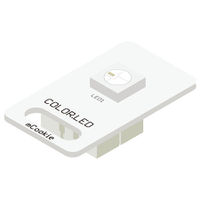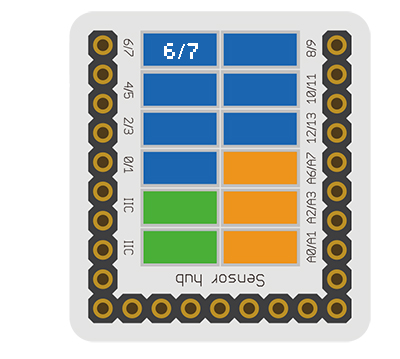Difference between revisions of "Sensor-Color LED"
(→Programming) |
(→Programming) |
||
| Line 69: | Line 69: | ||
***'''colorled_pin''' - defines the pin the ColorLEDs is connected to | ***'''colorled_pin''' - defines the pin the ColorLEDs is connected to | ||
***'''NEO_GRB + NEO_KHZ800''' - defines the type of ColorLED and the frequency it runs at, leave as is | ***'''NEO_GRB + NEO_KHZ800''' - defines the type of ColorLED and the frequency it runs at, leave as is | ||
| − | ** '''strip .begin()''' - initializes the ColorLED object | + | ** '''strip.begin()''' - initializes the ColorLED object |
| − | ** '''strip .setPixelColor(colorled_index, red_value, green_value, blue_value)''' - configures the color value for that colorled index, must call '''strip .show()''' for the ColorLED to actually display the change | + | ** '''strip.setPixelColor(colorled_index, red_value, green_value, blue_value)''' - configures the color value for that colorled index, must call '''strip.show()''' for the ColorLED to actually display the change |
***'''colorled_index''' - is the index of the ColorLED to configure, first in the chain is 0, second is 1, etc | ***'''colorled_index''' - is the index of the ColorLED to configure, first in the chain is 0, second is 1, etc | ||
***'''red_value''' - red value to set, between 0 (off) and 255 (maximum on) | ***'''red_value''' - red value to set, between 0 (off) and 255 (maximum on) | ||
***'''green_value''' - green value to set, between 0 (off) and 255 (maximum on) | ***'''green_value''' - green value to set, between 0 (off) and 255 (maximum on) | ||
***'''blue_value''' - blue value to set, between 0 (off) and 255 (maximum on) | ***'''blue_value''' - blue value to set, between 0 (off) and 255 (maximum on) | ||
| − | ** '''strip .show()''' - call this function after setting the color values for the ColorLED to actually display the color | + | ** '''strip.show()''' - call this function after setting the color values for the ColorLED to actually display the color |
==Example== | ==Example== | ||
Revision as of 20:41, 18 August 2017
| Language: | English • 中文 |
|---|
|
The product number of Sensor-Color LED is: MSDL11 Sensor-Color LED is full color LED, adopting single serial cascade protocol. Only one I/O port can control the RGB color of each LED on the line. If the power supply supports, it can support the cascade of as many as 1024 LEDs.
Contents[hide]Introduction of Sensor Pin
Features
Specification
Documents
UsageBasic FunctionalityThe ColorLED is a trinket which emits different colors based on the set red, green, and blue values. A Core module can control the ColorLED to output the desired colors. Note: ColorLEDs can be connected together in a daisy chain fashion, and each ColorLED can be addressed individually using the index number. First ColorLED being 0, second ColorLED being 1, etc. ProgrammingIntroductionThe ColorLED is used as an output pin. The Adafruit_NeoPixel library (Read more) is used to control the ColorLED. Key Functions
ExampleThis is a simple example which:
Note: Important lines of code are highlighted. //Include the required libraries to control the ColorLED
//Library guide at: https://learn.adafruit.com/adafruit-neopixel-uberguide/arduino-library
#include <Adafruit_NeoPixel.h>
//Define the pin the ColorLED is connected to
const int COLORLED_PIN = 6;
//Define the number of ColorLEDs daisy chained together
const int COLORLED_NUM = 1;
//Declare and initialize the ColorLED object
Adafruit_NeoPixel strip = Adafruit_NeoPixel(COLORLED_NUM, COLORLED_PIN, NEO_GRB + NEO_KHZ800);
void setup() {
// put your setup code here, to run once:
//Initial serial communication port at 9600 baud
Serial.begin(9600);
//Initialize the ColorLED class object
strip.begin();
//Initialize all ColorLEDs to 'off'
strip.show();
}
void loop() {
// put your main code here, to run repeatedly:
//Configure the first ColorLED to maximum red
strip.setPixelColor(0, 255, 0, 0);
//Set the ColorLED
strip.show();
//wait 1 second
delay(1000);
//Configure the first ColorLED to maximum green
strip.setPixelColor(0, 0, 255, 0);
//Set the ColorLED
strip.show();
//wait 1 second
delay(1000);
//Configure the first ColorLED to maximum blue
strip.setPixelColor(0, 0, 0, 255);
//Set the ColorLED
strip.show();
//wait 1 second
delay(1000);
}Copy and paste the code above to the Arduino IDE or Download the above example: n/a Program Download
Programming
Hardware Setup
Results
Application
ProjectHistoryGallery
|


